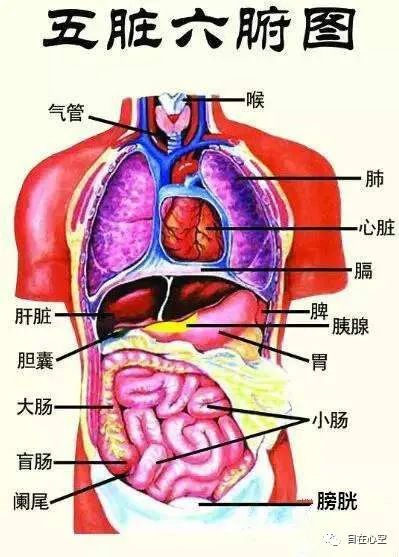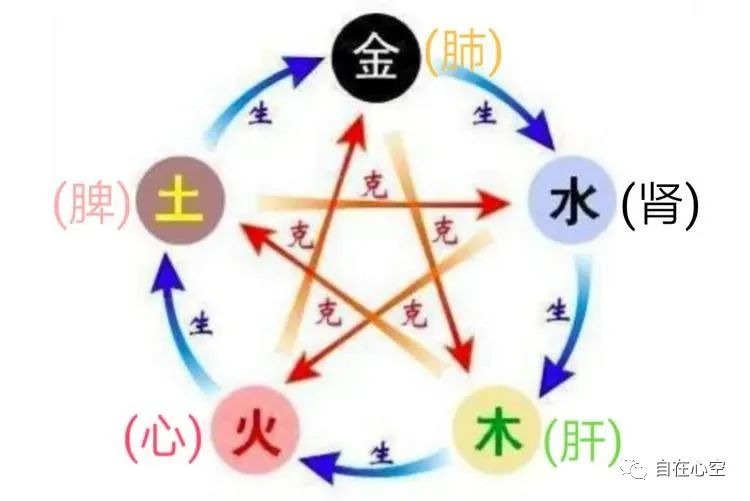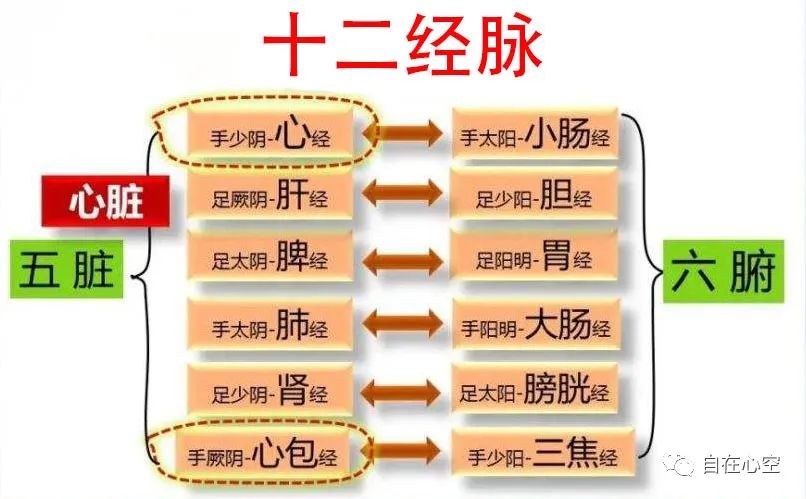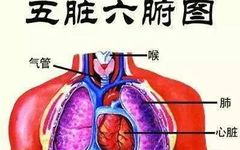The Five Organs and Six Bowels refer to various organs within the human body. “Zang” (脏) refers to solid organs, which include the heart (心), liver (肝), spleen (脾), lungs (肺), and kidneys (肾). “Fu” (腑) refers to hollow organs, which include the small intestine (小肠), gallbladder (胆), stomach (胃), large intestine (大肠), and bladder (膀胱), each corresponding to one of the five organs. Additionally, the thoracic and abdominal cavities are divided into the upper jiao (上焦), middle jiao (中焦), and lower jiao (下焦), collectively referred to as the San Jiao (三焦), which is considered the sixth bowel. The pericardium (心包络) is also referred to as the sixth organ, corresponding to the sixth bowel, San Jiao.
The Relationship Between the Organs and Bowels
The organs and bowels work in conjunction, with each organ paired with a corresponding bowel. The organs are Yin and internal, while the bowels are Yang and external. The relationship between the organs and bowels is connected through the meridians, meaning the meridians of the organs connect to the bowels, and the meridians of the bowels connect to the organs. They communicate through Qi, influencing each other, which allows for mutual effects in pathological changes.

Each of the Five Organs has a relationship of generation and restriction with one another. The interactions of generation and restriction among the Five Organs indicate that each organ supports the function of others, preventing deficiency, while also being able to restrain other organs to prevent excess. If the Qi of one organ is too strong, it can be restrained by the Qi of another organ; if the Qi of one organ is deficient, it can be supplemented by the Qi of another organ. For example, if the Qi of the spleen (土) is deficient, it can be generated by the heart (火); if it is excessive, it can be restrained by the liver (木); if the lung (金) Qi is insufficient, it can be generated by the spleen; if the kidney (水) Qi is excessive, it can be restrained by the spleen. This generative and restraining relationship tightly connects the Five Organs into a whole, ensuring the unity of the internal environment of the body.

The Twelve Meridians are connected to the organs and bowels within the body. Due to the relationship of mutual correspondence between the organs and bowels, the Yin meridians and Yang meridians of the Twelve Meridians also have clear associations with the organs and bowels. The Yin meridians correspond to the organs, while the Yang meridians correspond to the bowels, forming pairs of Yin and Yang.
Thus, six pairs of relationships are formed between the Yin and Yang meridians of the organs and bowels. For example, the Hand Taiyin Lung Meridian (手太阴肺经) corresponds to the Lung and the Large Intestine, while the Hand Yangming Large Intestine Meridian (手阳明大肠经) corresponds to the Large Intestine and the Lung.
The heart (心) is connected to the small intestine (小肠), its manifestation is on the face, its fullness is in the blood vessels, and it opens to the tongue;
The liver (肝) is connected to the gallbladder (胆), its manifestation is in the nails, its fullness is in the tendons, and it opens to the eyes;
The spleen (脾) is connected to the stomach (胃), its manifestation is in the lips, its fullness is in the muscles, and it opens to the mouth;
The lung (肺) is connected to the large intestine (大肠), its manifestation is in the hair, its fullness is in the skin, and it opens to the nose;
The kidney (肾) is connected to the bladder (膀胱), its manifestation is in the hair, its fullness is in the bones, and it opens to the ears and the two Yin.

Table of Correspondence Between the Five Organs, Six Bowels, and Twelve Meridians
|
Organ (Yin, Internal) |
Yin Meridian |
Bowel (Yang, External) |
Yang Meridian |
|---|---|---|---|
|
Heart |
Hand Shaoyin Heart Meridian (手少阴心经) |
Small Intestine |
Hand Taiyang Small Intestine Meridian (手太阳小肠经) |
|
Liver |
Foot Jueyin Liver Meridian (足厥阴肝经) |
Gallbladder |
Foot Shaoyang Gallbladder Meridian (足少阳胆经) |
|
Spleen |
Foot Taiyin Spleen Meridian (足太阴脾经) |
Stomach |
Foot Yangming Stomach Meridian (足阳明胃经) |
|
Lung |
Hand Taiyin Lung Meridian (手太阴肺经) |
Large Intestine |
Hand Yangming Large Intestine Meridian (手阳明大肠经) |
|
Kidney |
Foot Shaoyin Kidney Meridian (足少阴肾经) |
Bladder |
Foot Taiyang Bladder Meridian (足太阳膀胱经) |
|
Pericardium |
Hand Jueyin Pericardium Meridian (手厥阴心包经) |
San Jiao |
Hand Shaoyang San Jiao Meridian (手少阳三焦经) |
Because the meridians are mutually corresponding, they have physiological interconnections. Pathologically, they can influence each other, allowing for mutual application in treatment. For example, diseases of the Hand Taiyin Lung Meridian can be treated using the Hand Yangming Large Intestine Meridian, as these two meridians are mutually corresponding.
The theory of organ representation suggests that the human body is an organic whole connected through the meridian system, linking the Five Organs and Six Bowels, limbs, skin, muscles, and the seven orifices and two Yin. Internal changes in the organs can be reflected externally through the five senses and skin, allowing for observation of external manifestations of disease to understand the location of the disease, differentiate the nature of the pathogenic factors, and grasp the deficiency or excess of organ Qi.
Health preservation requires a foundation. This foundation is the Five Organs and Six Bowels. The Five Organs are where essence is stored. The Huangdi Neijing (《黄帝内经》) states, “The Five Organs store essence, and the Six Bowels transport it.” In relation to the meridians, the Five Organs and Six Bowels are where the essence resides. The presence or absence of essence in a person must be reflected in the Five Organs and Six Bowels. When the Five Organs and Six Bowels are full and abundant, the body will be healthy; conversely, if they are deficient, the body will be unwell.

